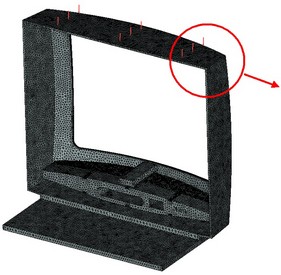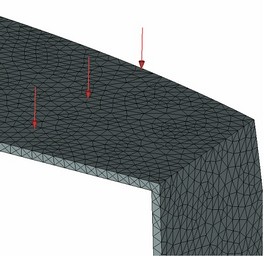 |
AutoFEM Analysis Purpose and Role of Meshes | ||||||
The main purpose of a finite element mesh is to adequately approximate geometry of the body being modelled, accounting for all features of the part geometry significant to the solution. The AutoFEM Preprocessor uses an effective automatic generator of finite element meshes, which lets the user control various modes of mesh generation in order to obtain meshes of the desired quality on different models. In AutoFEM, volumetric tetrahedral and triangular surface finite elements are used in finite element meshes, which, in theory, allow approximation with any required accuracy. Nevertheless, there are several preliminary recommendations regarding adequacy of calculation models using finite elements.
Firstly, quality of a solution may depend on the shape of the involved finite elements. Best results of finite element modelling are achieved, if the elements (tetrahedrons and triangles) forming the meshed model are close to equilateral ones. This is especially important for tetrahedral elements. Vise versa, if a meshed model contains elements, whose element-generating edges vary in their size greatly, then the modelling results could be of an insufficient accuracy. In such cases, it is desirable to minimize the number of such improper elements by means of the options provided in the finite element mesh generator.
|
|
«Poor» mesh of finite element model |
«Good» mesh of finite element model |
Thus, a user needs to control «quality» of the constructed finite element model based on a visual inspection or with the help of «Grid settings», aiming at possibly more uniform shape distribution of the elements involved in the mesh


More adequate mesh obtained after using mesh parameters settings
Secondly, besides the shapes of the finite elements, the solution quality is directly affected by the degree of discretization of the original geometrical model, that is «density» of the finite element mesh. The user can control this mesh generator's parameter by specifying a relative or absolute mean size of the finite elements approximating the body geometry, or by varying parameters that affect mesh generation on curvilinear models. Usually, a finer division yields better results in terms of accuracy. Nevertheless, remember that approximating a model by a large number of small finite elements inevitably leads to a high-order system of algebraic equations, which could adversely affect the speed of calculations. Quality of a finite element model can be assessed by subsequently solving several studies with ever-increasing degree of discretization. If the solution (such as maximum displacements and stresses) no longer shows significant difference on a denser mesh, then, to a great certainty, one can regard it as an optimal discretization level, so that a higher rate of discretization is unjustified.
|
|
Edge length - 6% |
Edge length - 1.5% |
In many cases, consider the estimated minimum level of a body's division as that delivering two to three layers of finite elements in the direction of applying loads and anticipated displacements.
Additionally, the mesh generator provides means for creating user-imposed mesh «refinement» in the areas of the model with sharp variations in the curvature, where one would expect high gradients of the sought values (stresses, for example).
Thus, one should pay much attention to the meshed model being generated for a finite element model, watching that the finite element mesh corresponded to the model geometry and had a satisfactory quality from the viewpoint of insuring a reliable and trustworthy solution to the physical problem being modelled.
See also: Creating the finite-element mesh, Condensation of the mesh